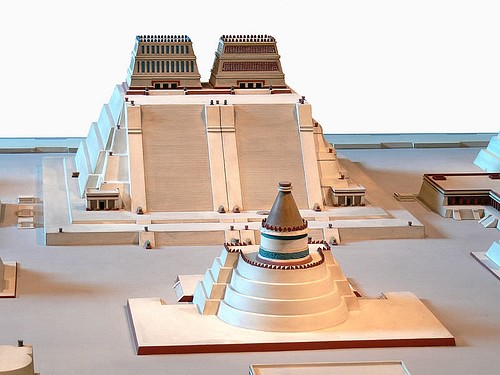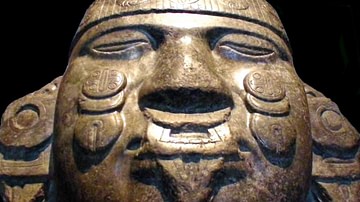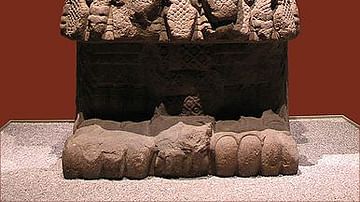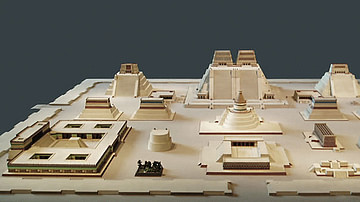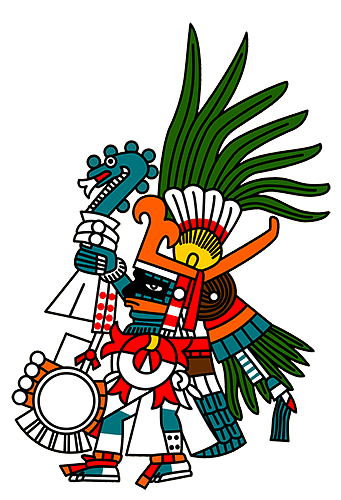
Huitzilopochtli (pron. Huit-zi-lo-pocht-li) or 'Hummingbird of the South' or 'Blue Hummingbird on the Left' was one of the most important deities in the Aztec pantheon and for the Méxica he was the supreme god. He was the god of the sun and war, considered the patron of the Aztec capital Tenochtitlán and associated with gold, warriors and rulers. His calendar name was Ce Técpatl (1 Flint) and his nagual or animal spirit was the eagle.
Unlike many other Aztec deities, Huitzilopochtli has no clear equivalents from earlier Mesoamerican cultures. In Aztec mythology Huitzilopochtli was the son of Omecίhuatl and Ometecuhtli, respectively, the female and male aspects of the androgynous primordial god Ometeotl. In an alternative version, the god is the offspring of Coatlίcue, the supreme earth goddess. Huitzilopochtli was also considered the brother of those other great Mesoamerican gods Quetzalcoatl, Tezcatlipoca and Xipe Totec.
Huitzilopochtli as the Sun
Huitzilopochtli famously avenged the murder of his mother Coatlίcue (or in some versions actually saved her) when he defeated his siblings the 400 Centzonhuitznahuac and Centzonmimizcoa on Mt. Coatepec, the snake mountain. According to the legend, Coatlίcue, whilst sweeping her temple, tucked some feathers under her breast and with these she became pregnant with Huitzilopochtli. Her children were outraged at this development and attacked Coatlίcue but when they decapitated their mother Huitzilopochtli sprang from the corpse with all his weapons in hand and lopped off his sister Coyolxauhqui's head. In some versions of the myth she had been the leader of the revolt, in others, she had been trying to warn Coatlίcue of the plot against her. In any case, Huitzilopochtli dismembered her corpse so that her torso fell to the bottom of the mountain and when he slung the head into the skies it became the moon. Huitzilpochtli then dealt with his other unruly siblings the Centzonhuitznahuac and the Centzonmimizcoa, putting an end to their takeover attempt and dispersing them into the heavens to become the southern and northern constellations respectively.
For the Aztecs the tussle between Coyolxauhqui and Huitzilopochtli was thought to reoccur everyday which explained the daily exchange for control of the sky between the sun and moon. Huitzilopochtli was believed to be accompanied on the first half of his journey across the sky by the spirits of fallen warriors (who would later return to earth as hummingbirds). From noon the god was then accompanied by the Cihuateteo, the spirits of women who had died during childbirth. When night fell Huitzilopochtli moved through the Underworld until dawn and he then once more travelled the skies.
Worship of Huitzilopochtli
Huitzilopochtli's rival as the most important Aztec god was Tezcatlipoca but at his city of Tenochtitlán the god was supreme. The focal point of worship to Huitzilopochtli was at the Aztec capital where he had a wooden statue and shrine alongside that of Tláloc atop the Temple Mayor pyramid or Hueteocalli. The god's temple was on the south side and marked the winter solstice and dry season - the traditional time of war - and the steps leading to Huitzilopochtli's temple were painted bright red to symbolise blood and war.
As Huitzilopochtli was such an important deity he was the beneficiary of human sacrifices whose blood would feed and strengthen the god. Victims usually came from war captives and they were led to the top of the Temple Mayor, their hearts were removed, they were skinned and the corpse decapitated and dismembered, perhaps in homage to Coyolxauhqui and her similar fate at the hands of Huitzilopochtli. The torso of the victim was flung down the steps of the pyramid to land at the base where, significantly, stone-carved snakes recall Mt. Coatepec and a massive round stone depicting a dismembered Coyolxauhqui was found. Meanwhile priests and nobles ate parts of the sacrificed flesh with the heart being most prized. In a more picturesque homage to Huitzilopochtli, flowers and quail eggs were offered to the god, images of him were strung with garlands and women danced the traditional serpent dance.
Huitzilopochtli was worshipped in the ceremony of Panquetzaliztli in the month of the same name when the god's birth on Mt. Coatepec was commemorated and he was also celebrated during the month of Toxcatl when an effigy or tzoalli made from dough using the amaranth plant and dressed as Huitzilopochtli was taken to the god's temple in a great procession and then eaten.
The Méxica, especially, revered Huitzilopochtli as they believed he had led them from the legendary Aztlán cave in the northwest desert on a protracted journey that eventually led to their new capital Tenochtitlán. During this migration priests had carried a huge idol of the god who whispered directions, gave the Méxica their name and promised great wealth and prosperity if he was suitably worshipped. Along the way the Méxica settled at different spots, none of which really suited their purpose. A decisive event in the migration was the rebellion incited by Copil, son of Huitzilopochtli's sister Malinalxochitl. This was in revenge for the goddess' abandonment by the Méxica but with Huitzilopochtli's help Copil was killed. The great war god instructed that the rebel's heart be thrown as far as possible into Lake Texcoco and where it landed would indicate the place the Méxica should build their new home, the precise spot being marked by an eagle sitting on a prickly-pear cactus. This is exactly what came to pass and the new capital of Tenochtitlán was built.
Representations in Art
There are few surviving depictions of Huitzilopochtli, probably because the god was relatively young in the Aztec pantheon and he was typically sculpted in wood rather than stone so that there are no surviving monumental representations of him. When he is represented, Huitzilopochtli may be depicted carrying his snake-shaped spear-thrower (atl-atl) which represents the fire-serpent Xiuhcóatl. He may also carry a shield, hold feathered arrows or darts and be painted with blue arms and legs. The god could be symbolised by either a hummingbird (huitzilin) - whose feathers he wore in his helmet - or an eagle sitting on a prickly pear cactus holding a snake in one of its talons, an image seen today in the national flag of Mexico.
